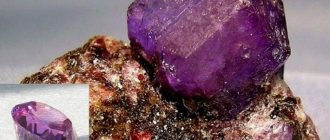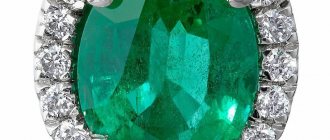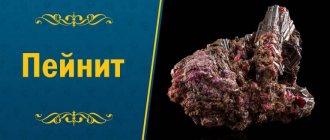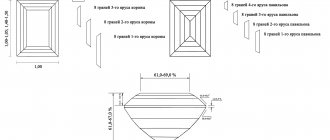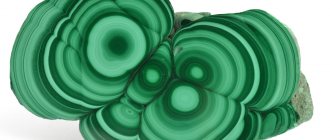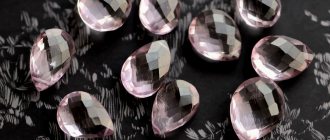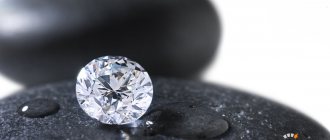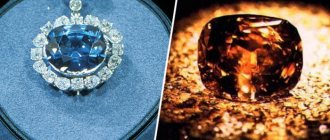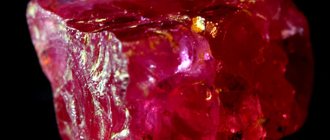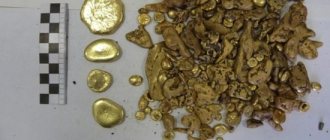Such rare precious and semi-precious stones are found in nature that their names cannot be found in any gemological reference book.
True collectors can “hunt” for years for the desired stone. A serious collector looks at ladies proud of a ring with a couple of carats as if they were a child who was given the coveted candy.
Forget about diamonds, emeralds, sapphires. These are not rare stones - just expensive ones.
Our heroes today are found very rarely, which is why they are valuable and interesting.
We will not give a complete list of these gems. But you will learn the names, properties and approximate price of some of these stones from the article. And, of course, about the rarest precious gem.
Hemimorphite
A rare collectible and jewelry mineral of the silicate class. Color ranges from blue, cyan to colorless.
Hemimorphite
There are quite a lot of deposits, but jewelry samples are rare.
| Formula | Zn4[Si2O7] (OH)2 x H2O |
| Color | Blue, pink, greenish, colorless |
| Stroke color | White |
| Shine | Glass |
| Transparency | From transparent to opaque |
| Hardness | 4 — 5 |
| Cleavage | Perfect |
| Kink | Conchoidal, uneven; fragile |
| Density | 3.4 - 3.5 g/cm³ |
| singonia | Rhombic |
| Refractive index | 1,614 — 1,636 |
The stone is cheap - from 5 to 40 US dollars, depending on the quality and color.
Crystals
Crystals from all over the world impress with their perfection: it’s hard to believe that they grew independently, without human help. However, the word “crystal” itself is often misused. What are real crystals, and what types are they?
Mineral crystals acquired their shape due to the peculiar arrangement of individual atoms, which is commonly called a crystal lattice . For example, in glass the atoms are arranged chaotically, and therefore a regular pyramid cut or cast from it will in no way be a crystal: at best, it is a man-made model of a crystal. A quartz “crystal” hand-carved from a fragment of crystalline material—fluorite—does not fit this definition either: fluorite has crystals of a completely different shape, and here we are dealing with the imagination of the master. But a crystal of the same quartz, the edges of which, initially rough and covered with oxides, were ground and polished while maintaining natural proportions, will remain a crystal - albeit an ennobled one.
Finding Shape
It is generally accepted that each mineral is characterized by a certain crystal shape: for example, we are accustomed to ideal cubes of pyrite or elongated columns of tourmaline. However, this does not always happen. The same pyrite can form not cubes, but octahedra, which are based on the same crystal lattice. One of the record holders for the variety of forms is calcite: it can grow in the form of pyramids, prisms, thin plates, needle-shaped crystals and their various combinations.
Why does this happen? To understand the diversity of crystals, scientists use two terms: syngony and habit . Syngony is determined by the structure of the crystal lattice and allows us only to guess how a crystal of this mineral could grow under ideal conditions. And the habit - the final appearance of the crystals - is influenced by temperature, the growth rate of individual faces, chemical impurities, possible obstacles, changes in the environment and many other factors. There are only six syngonies, but there are hundreds of possible crystal forms.
Rare and valuable crystals
People did not immediately learn how to cut precious and semi-precious stones. But already in ancient times they paid attention to the perfection of forms created by nature, and only then began to master the art of cutting, beginning to give fragments of colored stones the same brilliance and perfection that they saw in the best natural crystals.
Crystals are usually valued for their purity of color and transparency. But some inclusions make them even rarer and more expensive. For example, polychrome tourmaline crystals, whose color gradually changes from purple to yellow-green, are the dream of many collectors. Quartz crystals with inclusions of golden rutile needles give it special value and turn it into a real masterpiece of nature that can be admired endlessly. Rock crystal crystals with so-called “phantoms” are very interesting. When the growth of a crystal temporarily stopped, mineral particles settled on its edges, and when growth continued, a reduced “ghost” remained in the crystal - a phantom.
Giant crystals are also found in nature: for example, in one of the caves in Mexico, selenite crystals up to 11 meters grow. The Ural Geological Museum houses a quartz crystal 1.75 meters high and weighing 784 kilograms. In our store you can purchase unique large crystals of amethyst, rock crystal, morion and kyanite up to several tens of centimeters in size.
Inexpensive crystals
You can buy a real crystal, cut by nature, even with the most modest budget. Regular cubes of Peruvian and Spanish pyrite, small amethyst crystals from China, rock crystal and rauchtopaz mined here in the Subpolar Urals, individual crystals of blue corundum or almandine garnet - all these samples are quite affordable.
Guaranteed Authenticity Crystals
The Stone Experts store gives a 100% guarantee of authenticity for all crystals, as well as their intergrowths, doubles, druses and brushes. We do not sell fakes or imitations, and if the color of a natural stone has been enhanced in the laboratory or the edges of the crystal have been polished, we always inform our customers about this. If you wish, you can order a gemological examination certificate for any sample purchased from us.
Grandidierite
Until recently, it was considered one of the rarest jewelry stones. It was discovered in 1902 in Madagascar. Its beauty and rare property - trichroism - place it among the best precious stones. The gem radiates three colors at once: colorless, blue-green, green, and twilight dark.
Grandidierite
In the 100 years since its discovery, less than 20 gems suitable for cutting have been found. In 2014, a deposit of gem-quality grandidierite was discovered in Madagascar.
Gems are occasionally found in:
- Canada;
- India;
- Japan:
- Algeria.
But the highest quality stones can only be found in Sri Lanka and Madagascar.
| Category | Silicate minerals |
| Title in English | Grandidierite |
| Formula | MgAl3O2(BO3)(SiO4) |
| Group | Group of precious stones |
| Color | Blue; green |
| Stroke color | White |
| Shine | Glass, Mother of pearl |
| Transparency | Translucent, Transparent, Translucent |
| singonia | Rhombic |
| Hardness | 7 — 7,5 |
| Cleavage | Perfect |
| Density, g/cm³ | 3 |
| Kink | Fragile, Uneven |
Average quality grandidierites sell for $2500-3000 per carat. Premium stones can cost up to US$50,000 per carat.
Eremeevit
Every year, no more than a dozen gem-quality crystals are found in the world. The gem is one of the rarest stones on the planet.
The first specimen was discovered in 1859, near Nerchinsk. The mineral was studied by the French mineralogist A. Damour, and gave it the name “eremeyevite”. The mineral was named after the Russian mineralogist Eremeev.
Eremeevit
There are several places on the planet where you can find this rarity:
- Russia;
- Namibia;
- Burma;
- Madagascar;
- Germany.
Almost all cut crystals do not exceed a weight of two carats.
We recommend: TOP 5 widow's stones
The stone is hard (6.5-7.5), but fragile. This makes cutting work more difficult.
| Formula | Al6[BO3]5 (F,OH)3 |
| Color | Colorless to pale blue |
| Stroke color | white |
| Shine | Glass |
| Transparency | Transparent |
| Hardness | 7,5—8 |
| Cleavage | Imperfect |
| Kink | conchoidal |
| Density | 3.3 g/cm³ |
| singonia | Hexagonal |
Jewelry with eremeevite cannot be found in jewelry stores; They are rarely found at auctions.
The gem is amazing in color: it can be blue, cornflower blue, colorless, yellow or yellow-brown.
No fakes or ennobled stones have been identified so far.
The cost of jewelry quality crystals starts from $500 US per carat.
The price of commercial quality crystals is from 100 to 250 dollars. But even they are not easy to find.
For your information: a 2.93-carat eremeevite was sold at auction for $5,860.
Poudretteite
It was first discovered in Canada in the late 1980s. The mineral was found in the mines owned by a family with the surname Poudrette, in honor of which it was given the name “poudretteite.”
From the late 80s to the present, only 300 such stones have been found, as a result of which the cost of 1 carat of the mineral starts at $2,000. The color of the stone is almost whitish with a slight pink tint. In rare cases, it is possible to find a purple mineral.
We recommend reading: How much can you hand over an autocatalyst?
Red diamond
The red diamond is now considered the rarest gem in the world.
Several red diamonds are known to have been found. Moreover, most weigh less than half a carat.
Red diamond
About fifty red diamonds are known in the world.
You can find out about the discovery of a red diamond at auctions (if the stone reaches there). The price will start at a million dollars per carat.
Important: it must be a natural, not improved, not refined mineral.
Majorite
Majorite is named after physicist Alan Major, a unique purple mineral also called purple garnet. Garnets acquire this color when exposed to enormous pressure. It was first discovered in Western Australia. The cost of the 4.2-carat mineral was $6.8 million.
0
Red beryl
Belongs to rare precious stones from the beryl family. Many will say that the most expensive beryl is emerald. And they will be wrong.
Red beryl
Red beryl can be called bixbite.
| Formula | Be3Al2Si6O18 + Mn |
| Color | red |
| Shine | glass |
| Hardness | 7,5—8 |
Crimson beryl - pezzotaite. Read more about the varieties of beryl here. Buying jewelry with these gems is a great success. Most bixbits do not reach the market and auctions; Gems are intercepted by interested collectors.
Interesting: “I’ve been hunting for these stones for 13 years, and only now we were able to put together a collection” (Michael Ko, founder and designer of the Caratell brand).
Bixbite is mined in two places on Earth. This is the USA: the states of Utah and New Mexico.
Both varieties (bixbite and pezzotaite) are vanishingly rare in gem quality. The price for such a gem starts from $5,000 per carat and reaches $20,000.
Important: pezzotaite is a valuable stone, but still much cheaper than bixbite. Therefore, when purchasing red beryl, it is better to have the stone examined by an expert.
cat's eye
Cat's eye is the second known variety of chrysoberyl to have a "cat's eye" effect. Sometimes, instead of the cat's eye effect, a so-called asterism (optical effect) appears in the form of a four-pointed star. This is due to the presence of numerous and tiny channels filled with gas, which form ordered shapes parallel to the long axis of the crystal. When they intersect with each other, an asterism effect is created.
Mawsitsit (mav sit sit)
This is a rare polymineral conglomerate. It includes:
- cosmochlor;
- eckermannite;
- jade;
- albite.
The color of the gem is specific and original; it is difficult to confuse it with another. The mineral is green in color with black and white veins.
Mawsitsit
They often try to pass off Mavsitsit as chrome jadeite. Whether this is a sincere delusion or a blatant deception - in any case, this is not chrome jadeite. It is incorrect to pass off the mineral as fei chui or jadeite.
This mineral is highly valued in Southeast Asia. The cost of stones is generally determined not by weight, but by the aesthetic qualities of the stone.
The traditional cut is cabochon. The “higher” the stone, the more expensive it is. The price can range from $70 to $300 per stone. Add here a frame (usually gold).
Musgravit
The first pebble was discovered in southern Australia, relatively recently - in 1967. Several gems have been found in Greenland, Madagascar and Antarctica.
We recommend: Green gems: TOP-18
It is believed that there are only 8 faceted musgravite crystals (according to other sources, no more than 20) on the entire planet. The weight of the crystal does not exceed 1 carat.
Musgravit
It is clear that such rarities cannot be bought in a store or at an auction. But it seems that the price of a carat of musgravite is no less than $35,000.
The price depends on the color: the green “modification” is cheaper, for the purple one you will have to pay a lot more bucks.
Important: if you are planning to buy Musgravit, get a certificate. The gem is very similar to taaffeite; only a specialist can distinguish them.
Charoite
The mineral was discovered in 1960 on the banks of the Chara River, located at the junction of the Irkutsk region and the Sakha Republic. Stone reserves are depleted too quickly, so annual production cannot exceed 100 tons.
Charoite cannot be grown artificially. The color of the mineral is lilac in different shades. The cost of 1 carat is $50.
Painite (paintite)
Red with an orange tint, high hardness, bright shine, pleochroism... A gem with such properties would occupy a high place in the hierarchy of jewelry.
Paintitis
Its total rarity makes the price of paintite as unique as the gem itself.
| Formula | CaZrBAl9O18 |
| Color | ruby red to brown-orange |
| Stroke color | white |
| Shine | Glass |
| Hardness | 7,9-8,0 |
| Density | 4.01 g/cm³ |
| singonia | Hexagonal |
There are 18 faceted crystals of jewelry quality. There are crystals of exceptional beauty and transparency, but only 3 of them are described.
For your information: it is useless to steal all the rarest stones for resale. They cannot be sold - the names of the legal owners are known.
In 2005, Guinness World Records declared paintite to be the rarest gemstone in the world. The number of minerals mined has since increased. But most gems are of very low quality. There are no official statistics on the number of faceted paintites. Any high-quality crystal flies off the market at the speed of light.
There is simply no upper limit on cost (according to experts).
Rare minerals: description and characteristics
From the list of rare ones, only tanzanite and diamond are heard. The names of other natural minerals mean little to most stone or jewelry lovers. Let's look at them in more detail.
Painite
The mineral was named after A. Payne, the mineralogist who discovered it (Burma, 1956).
Over half a century, only 18 pieces of jewelry were found. This served as the basis for including painite in the Guinness Book of Records for 2005 as the rarest on Earth.
Painite is one of the rarest stones in the world.
This status lasted less than a year: Burma donated half a thousand crystals from the new deposit. In terms of quality, they could not be compared with the “veterans”, but in the world painite (or painite) is no longer considered the rarest.
The stone is endowed with pleochroism: from ruby red to brownish orange.
The most valuable are the rarest ruby-red transparent specimens. This is the property of private or corporate collections. Not for sale, so the price is unknown.
Publicly available options: darkish specimens of medium quality and below – $30–450, cut red specimens of decent quality – from $5–9 thousand per carat.
Tanzanite
A rare variety of zoisite stone. Named after the place of production (the only one in the world) - the African state of Tanzania.
1.22-1.73 million carats are mined annually. If no new deposits are discovered, reserves will dry up in 17–19 years.
There is one tanzanite for every thousand diamonds mined.
The color range is from blue to blue-violet, sometimes with brownish or yellowish segments.
Due to the presence of vanadium, it has trichroism, that is, it changes color in three colors: blue-violet-red, purple violet-blue-green.
Tanzanite is a beautiful and rare mineral found only in Tanzania.
Large transparent blue-violet crystals were brought to light half a century ago by the Tiffany jewelry house. To improve color characteristics, the mineral is heated and cut in a special way.
Cut stones sell for $520+ per carat.
One of the largest (more than 122 carats) is the property of the Smithsonian Institution (USA). Rare smaller specimens are owned by gemological laboratories and centers, for example, Moscow State University.
Taaffeit
Also named after its discoverer: discovered by gemologist Count Richard Taaffe among the spinels of Ceylon (1945).
Taaffeit
The only mineral identified after cutting:
- The number of copies in the 20th century was calculated in just a few: since 1949, three stones have been found.
- The situation changed by the 3rd millennium: new generation equipment made it possible to identify hundreds of taaffeites among the spinels of Tanzania.
- Raw materials are also supplied by China, Madagascar, and Burma. In Russia, this rare mineral was found in the Urals, Karelia, and the Arctic.
Sri Lanka has top-class material. The 9.3-carat faceted taaffeite is the largest known.
Color range – lilac, pink, red-violet, greenish, bluish shades, colorless specimens.
Small raw materials cost $6 thousand per gram (stones no larger than a gram).
Faceted – $450–1790 per carat.
Musgravit
Purple musgravite is a rare breed. Named after the place of its first discovery - the Musgrave Mountain Range (Australia, 1967). Local raw materials were valued as ornamental stones: one of the Arab sheikhs ordered the bedchamber to be lined with them.
Musgravit
The first musgravite of jewelry quality was found almost 30 years later in Sri Lanka: in almost three decades, only 18 stones (the largest is almost 6 carats).
The color scheme is lilac, violet purple, pinkishness, delicate yellow-green, green shades.
The rarity of musgravite is partly due to its similarity to taaffeite and spinel. They learned to reliably distinguish minerals by 2003.
This was important in terms of jewelry appraisal. The rarer musgravite is valued twice as much as taaffeite: $2–36 thousand per carat.
Benitoite
This rare mineral is named after the place of its first discovery (1906, San Benito County, California):
- It was identified as a sapphire, but shone like a diamond and glowed bright blue under ultraviolet light.
- The crystals that come into circulation are smaller than 2 carats. Larger specimens are rare and are counted individually (a little more than a dozen, the most massive is 15.51 carats).
- Colors – blue range, from pale through violet, red, blue shades. Colorless specimens are rare, and often have a spontaneous color distribution (densely colored blue edges and a “pale” center, sometimes with pinkishness).
- Under ultraviolet light it glows blue-white, blue neon. Endowed with pleochroism from blue, violet-red to achromatic.
Benitoite is the state stone of California.
Since 1984, benitoite has been the state stone of California.
About 2.52 thousand carats are extracted in the world annually, but only California produces jewelry-quality specimens. Collectible material is supplied by Belgium, the USA, New Zealand, and single copies are found in Japan.
The price is $400-4 thousand per carat, depending on the size, color, and transparency of the stone.
Grandidierite
Rare blue gemstones. Grandidierite was named in honor of A. Grandidier, who devoted himself to the study of Madagascar flora and fauna: the first stone was found on this island (1902).
A century later, Canadian gemologist M. Burford bought local grandidierite from Sri Lanka. The crystal was transparent, unlike Madagascar stones.
Grandidierite is only one perfect stone.
Lankan pebbles were mistaken for serendibite. M. Burford had it cut (0.29 carats remained) and sent it to Germany for identification.
Analyzes confirmed that this is transparent grandidierite:
- The color scheme of a rare stone - blue, with greenish or blue - is created by iron.
- It has trichroism: blue-green-achromatism.
- The stones are counted in singles (less than 20), specimens larger than a carat go for $19–25 thousand.
No new deposits have been discovered: only Sri Lanka and Madagascar. Single crystals are supplied by Norway, Greenland, and Suriname.
The transparent Sri Lankan pebble was bought by the owner of the Swiss Gemological Laboratory, jeweler Edward Gübelin. The cost of the rare stone was estimated at $35–100 thousand.
Poudretteite
The rarest pink stones with an interesting history:
- The mineral is named after the owner of the uranium-cerium quarry where it was first discovered (Canada, 1960s).
- The unusual stone was examined only 20 years later, confirming its novelty. This caused a stir; two dozen transparent crystals larger than carats and three hundred smaller ones were discovered at the mine.
- Myanmar became the supplier of jewelry-quality specimens. Here in 2000, a rare light purple transparent poudrettite (or poudrettite) was found.
- Over the next seven years, 30 poudrettites were identified, almost all smaller than caratites. Of the most massive (22 carats), just over 9 remained after cutting.
Poudretteite
The colors of powdertite are delicate violet or pinkish. There are rare colorless specimens.
Endowed with pleochroism - from colorless to purple pinkish or brownish.
The cost of stones smaller than carats is $2.4–10.7 per carat. Further increases in geometric progression.
Eremeevit
Its discoverer Pavel Eremeev mistook this rare mineral for aquamarine. Crystals were discovered in Transbaikalia a century and a half ago.
Eremeevit
The optical features of the stone, named after the Russian mineralogist, were of interest only to specialists. Read more about eremeyevite here.
Among the eremeyevites, the rarest minerals are light yellow. The most “massive” one weighs 60 carats (12 grams).
Jewelry crystals measuring up to 1.5x10 cm were found in pegmatite placers in Namibia (1970s):
- The colors are the same as aquamarine plus colorless, light beige or yellowish, pinkish.
- There are only half a thousand cut stones; 3–4 are added per year.
- The stone is not particularly beautiful; the price is affected by rarity: samples of high purity are estimated at $1.65 thousand per carat.
The rare mineral is also found in the mountainous regions of Germany and in the Tajik part of the Pamirs. But the crystals are small; after cutting, a maximum of two carats remains.
Variants of the name: jeremievit, dzheremeyvit.
Blue Serendibit
A stunningly beautiful blue mineral from Sri Lanka. Particularly rare: only three faceted crystals (0.35-0.56 carats) are registered.
Blue Serendibit
The smallest one went for $14.3 thousand.
Bixbit
Bixbite (or Red Beryl) is named after the mineralogist who described the first specimens:
- At the dawn of the twentieth century, the American mineralogist M. Bixby added it to the list of stones in the state of Utah.
- The crystals are 1–3 cm long; after cutting, less carats remain. The largest processed bixbit weighs 10 carats.
- Transparent, defect-free specimens are twice as expensive as emeralds (green beryls).
- There are deposits only in the USA, extraction is labor-intensive, so the price is appropriate: $9.9+ thousand per carat.
Bixbite
Bixbite is the national mineral of the United States.
Majorite
The second name is purple garnet. This coloration occurs under enormous pressure.
Majorite
First discovered in southern Australia, named after physicist Alan Major. The stone is expensive, although it is classified as semi-precious: a 4.21-carat crystal was valued at $6.82 million.
Red diamond
The rarest gem: diamond mining historians have recorded only fifty red processed diamonds.
Raw materials are supplied by the only deposit on the planet - the Australian Argil mine.
Red diamond
Several carats are found every year. The raw materials are small, the stones are larger than 0.1 carats. Available only at first level auctions.
The price starts at $1 million per carat. The largest jewelry stone, Moussaieff Red, 5.1 carats, cost $8 million ($1.6 million per carat).
Poudrettite (Poudrettite)
An extremely rare mineral from colorless to pale pink. It has strong pleochroism: light brown - purple-pink.
Poudretti
| Mineral color | colorless, very pale pink, pale violet |
| Transparency | transparent |
| Shine | glass |
| Hardness (Mohs scale) | 5 |
| Density (measured) | 2.51 |
| Radioactivity (GRapi) | 61.48 |
First found (and still sometimes found) in a Canadian mine owned by the Poudrette family.
Several crystals were discovered in Myanmar. 300 gems were donated by the Poudret family mine. Not all of them are of jewelry quality. And there are no more than 20 stones weighing more than a carat.
The cost of poudretteite is from 3 to 10 thousand US dollars per carat (depending on the quality and weight of the stone).
The largest poudrettite (cut) weighs 9.4 carats.
Benitoite
This impressive blue stone was only found near the San Benito River in California, USA, although some sources claim that a limited number were found in Japan and Arkansas, USA, but they did not have gemstone qualities.
One of the hallmarks of benitoite is how gorgeous it looks under ultraviolet light.
, where it glows a dazzlingly beautiful color reminiscent of glowing blue chalk. What's strange is that even though it was first described at the turn of the 20th century and its composition has been known for decades, the origins of the color and its luminous properties still remain a mystery.
Taaffeit
One of the rarest minerals in the world. Named after the discoverer.
Taaffeit
The colors of the stone range from pale pink to lavender.
| Formula | Mg3Al8BeO16 |
| IMA status | Valid |
| Taxonomy according to IMA (Mills et al., 2009) | |
| Class | Oxides and hydroxides |
| Subclass | Complex oxides |
| Supergroup | Högbomita |
| Group | Taaffeita |
| Color | Colorless, greenish, mauve |
| Shine | Glass |
| Transparency | Transparent to translucent |
| Hardness | 8 — 8.5 |
| Fragility | Fragile |
| Cleavage | Imperfect |
| Kink | Conchoidal |
| Density | 3.6 g/cm³ |
Gems are occasionally found in placer deposits in Sri Lanka and southern Tanzania.
The authenticity of the gem helps determine the effect of double refraction of color.
The cost of crystals is from 2000 to 10,000 US dollars per carat.
Alexandrite
An amazing stone that can change its color was discovered in 1830 in the Urals in Russia and named after the Russian Tsar Alexander II. Alexandrite is a variety of chrysoberyl and appears blue-green in sunlight, but turns red-violet in incandescent light. The cost of this gem weighing up to 1 carat is $15,000, but a stone weighing more than one carat will cost $70,000 per carat.
0
Thugtupit
The Greenlandic Eskimos have long known about this stone and highly valued it. They called it “tutu,” which translated means “the blood of a deer that seeped through the stones and turned into love.”
Thugtupit
| Formula | Na4[BeAlSi4O12]Cl |
| Color | Dark red with purple tint |
| Stroke color | White |
| Shine | Glass |
| Transparency | Opaque, sometimes translucent |
| Hardness | 6 |
| Kink | Uneven, conchoidal |
| Density | 2.36-2.57 g/cm³ |
| singonia | Tetragonal |
| Refractive index | 1,496 — 1,502 |
We recommend: Review of BLACK STONES
In lithotherapy and esotericism, this is one of the most valuable and rare stones. Eskimos call the gem the embodiment of earthly love.
It’s interesting: in the dark, tugtupit dims and turns pale. Once exposed to light, it quickly restores its deep red color.
Highly valued by collectors, it can be used as an ornamental stone.
Translucent, beautifully colored gems are found only in Greenland.
The price of such cut stones ranges from $1000 to $2500.
Cabochon-cut gems are much cheaper.
The most unusual natural forms of precious stones
Sometimes traditional stones take on bizarre shapes that are simply breathtaking. It happens that a tree does not smolder, but becomes a stone, and the veins in it turn into opal or chalcedony.
A tree that became a stone
Do you think the next photo is a cracked egg?
Extraordinary opal
No, it's an opal hidden in an unattractive-looking stone. Such stones are called geodes.
Geode with opal
Boulder opal is less expensive than black opal, but it is rarer. This stone is notable for its ability to change color. To prevent it from losing its properties, it is left in a frame made of iron ore, in which the stone is found.
Boulder opal: lake in the palms
Malachite cannot be called a rare stone, but the designs on it are so unique and bizarre that they never cease to amaze. Malachite crystals grow from the center like rays; they grow due to the copper content in the solution surrounding them, and the saturation of the shade depends on its concentration. Therefore, in nature there cannot be two identical stones.
Unique malachite pattern
Hackmanite
The rarest variety of minerals from the sodalite rock. More often than not, hackmanite is the pride of collectors. But it is also used as a gemstone for jewelry.
Hackmanite
Informative: the highlight of hackmanite is tenebrescence (photochromism). This is the property of a stone to change color under the influence of ultraviolet radiation (whether it is the Sun or a UV lamp).
The color changes from pink to purple.
It is impossible to counterfeit hackmanite.
And there are also hairy stones...
A rare mineral - bissolite - was found in the Urals. The stone seems to have hair. In fact, hairs are the finest crystals. Belongs to the rock group of amphiboles. The specimen found in the Urals weighs almost 4 kilograms; this is rare for bissolites. Such stones cannot be inserted into earrings or necklaces; a good example of the “shaggy stone” is the dream of any collector.
Bissolit
If you want to wear a “hairy gem” in jewelry, you should buy a demantoid (this is a rare type of garnet). And certainly Ural. They are the only ones with a ponytail. These are byssolite inclusions. The value (and rarity) of demantoid with such an inclusion is much higher than that of ordinary garnets.
Ural demantoid 1.18 carats
Rare black stones
There are at most hundreds of black specimens of ordinary jewelry minerals:
- spinel – the “noble” type – is an object of desire for luxury lovers and collectors;
- sapphire - the last specimen was found 80 years ago; stones traded on the market are artificially colored;
- Morion is the only semi-precious independent mineral (not a variety) of the rare black ones. Jewelers use artificial analogues, natural ones do not reach the market, the cost is unknown.
Morion
Black minerals are considered to belong to sorcerers or self-sufficient individuals. Each is a strong energy stone, actively used in lithotherapy.
Space present
Meet carmeltasite. This is a gift from outer space; Mother Earth never gave birth to such stones. Some people claim that the gem will cost more than a diamond. The mineral is black with a metallic sheen and may have blue-green and orange tones.
Carmeltazit
Some experts believe that such minerals can form on Earth (where the crust borders the mantle).
It is believed that in the future carmeltazite will be one of the most expensive stones.
For now, this is a rare gem with a great future.
Tanzanite
Tanzanite, found only at the base of Mount Kilimanjaro, is one of the rarest minerals on Earth. In fact, it is 1000 times rarer than diamond, which may mean its supply is limited. The history of tanzanite is young: it received its name from the New York jeweler Tiffany & Co in 1968.
The formation of tanzanite began about 600 million years ago, when the eruption of Mount Kilimanjaro created the unique conditions necessary for the formation of crystals deep within the Earth. Starting with a brownish hue, tanzanite's beautiful blue-violet hues appear when it contains small amounts of vanadium impurities and oxidizes.
